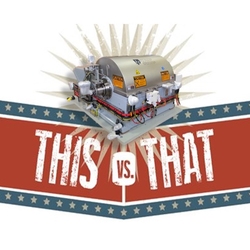Mixer-Settlers vs. Centrifugal Liquid-Liquid Separation

Mixer-settlers work on many of the same principles as centrifugal liquid-liquid separators. Both mixer-settlers and centrifugal liquid-liquid separation can be considered solvent extraction processes, although these machines do have other uses. While these processes are similar, they have distinct differences that can be helpful to note when searching for the right machine. Let’s dive in!
Mixer-Settlers
Mixer-settlers rely on gravity to separate out components in a solution with different specific gravities.
In the solvent extraction process, mixer-settlers use two immiscible liquids of different specific gravities to transfer a component (solute) between the carrier liquid and the solvent. Solvent extraction processes refer to the two liquids as heavy liquid (or heavy phase) and light liquid (light phase). Either the solvent or the carrier liquid can be the heavier component.
In a mixer-settler device, the heavy and light liquid are fed together into a chamber where they are stirred by a mechanical agitator such as a turbine. This intimate contact allows the solute(s) to be transferred from the carrier liquid to the solvent. After the two liquids (phases) are mixed, they are drawn into the settling tank. There, the two liquids separate by static decantation. Coalescing plates are used to aid in the separation of the liquids. The heavy liquid settles towards the bottom and the light liquid settles towards the top – these highly-concentrated areas near the top and bottom are called the clarification zones. It is from these zones that the light liquid and heavy liquid are extracted.
Centrifugal Liquid-Liquid Separation
Rather than relying on gravity, centrifuges use centripetal acceleration to apply up to 3,000 times the force of gravity. This force and the internal coalescing plates drastically shorten separation times and allow separations at very small specific gravity differences.
Since centripetal acceleration is relative to the rotation of the centrifuge, the liquids tend towards the center and edge of the centrifuge rather than the top and bottom. The heavy liquids move towards the outer edge of the centrifuge while the light liquids move towards the center. The heavy liquid is fed near the center of the centrifuge, but not at the center. The light liquid is fed towards the edge of the centrifuge, but not at the edge. As the centrifuge spins, the light liquid and heavy liquid are drawn past each other and - as they contact - the elements (similar in purpose to the coalescing plates) make intimate contact with each other. As in mixer-settlers, the solute (component to be extracted) is transferred from the carrier liquid to the solvent. The heavy and light liquids concentrate at the edge and center respectively. These areas are further center and further to the edge than either feed opening and are also called the clarification zones. The heavy and light liquids are extracted here, similar to the location in a stationary mixer-settler.
Your Better Option
Centrifugal Liquid-Liquid Separators minimize the solvent necessary for the extraction process and optimize the solute contained in the solvent. The centrifugal separator is also a faster process than mixer-settlers because of the forced acceleration, and has a smaller footprint to boot.
If you are searching for the liquid-liquid separator that works best for your business, be sure to contact us! We are experts in our field, and offer our own centrifugal separator – the Podbielniak® Contactor – that has stood the test of time for over 60 years.
